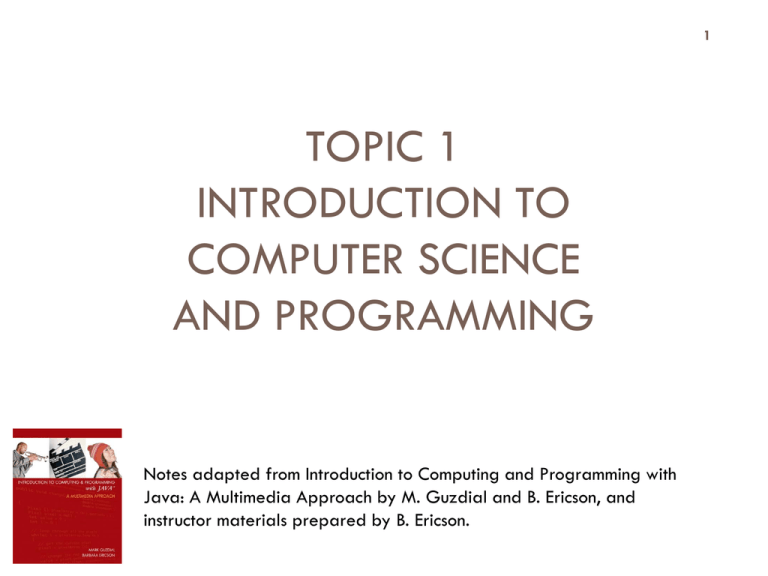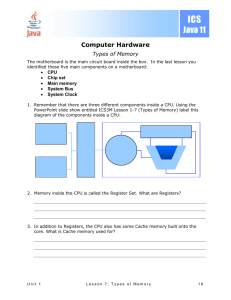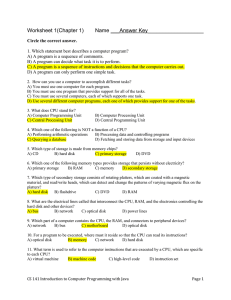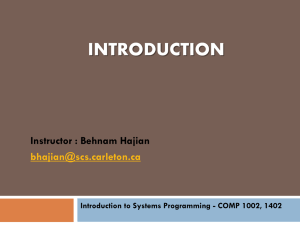cs1026_topic1 - Computer Science
advertisement

1
TOPIC 1
INTRODUCTION TO
COMPUTER SCIENCE
AND PROGRAMMING
Topic 1
Introduction
to Computer
Science
Notes adapted
from Introduction
to Computing and Programming with
Java:
A Multimedia
Approach by M. Guzdial and B. Ericson, and
and
Programming
instructor materials prepared by B. Ericson.
Outline
3
What
will you get out of this course?
What is computation?
What is computer science?
Roles of Computer Science in our society
What's in a computer
What is a program
What is programming
What a compiler does
Lets learn about Java
Why this course?
4
Learn how to think like a computer scientist
Learn problem solving
Read and write code
Understand object oriented programming
Be well prepared for CS1027
Understand objects and classes
Know a bit about the computing field
What is computation?
5
The tool is the computer – the action is computation
Computers carry out actions
Think of a recipe...
Place
butter in pan
Add eggs
If you like them cooked all the way
Flip
If
over
not, keep cooking while they aren't done yet
Eat!!
What is computation?
6
A recipe is a set of steps
A computer carries out a set of steps based on what
the programmer tells it
It can do any set of basic instructions
What is Computer Science?
7
The design, analysis, implementation, …
of algorithms (recipes),
that solve problems.
Roles of Computer Science
8
Maintaining the technical infrastructure
network, software
But also many algorithmic challenges
Artificial Intelligence (AI) for games
search or auction algorithms (Google, Bing)
medical imaging
cryptology (RIM)
low-power chips
Whats in a computer?
9
Memory
CPU – Central
processing unit
–
–
ALU → arithmetic
logic unit
Program Counter
Peripherals
I/O and secondary
memory
Memory – Hard disk
10
Slow, cheap and huge
Its a physical item, so it actually has to move to
do anything
Items here get loaded into RAM and then the
cache if its being executed
Memory - RAM
11
Main memory – RAM
Random
access memory
Faster, holds less
Disappears when you shut off the computer
Made of switches that are either 0 or 1
Holds programs currently executing
Memory - Cache
12
In the CPU
Small
Fast
Memory - Registers
13
Very few, nothing faster
Called “working registers”
Say you run a program... gets loaded to RAM,
first part goes to cache, then current items go to
registers
Peripherals
14
Outside pieces of a computer that depend on it
such as:
Mouse
Keyboard
Speakers
Printers
Etc...
•
•
•
•
•
External memory and I/O
15
Secondary Memory: hard disks, CDs, DVDs, USB sticks
Provide long-term storage
Organized as files, each of which has
a file name and a folder (directory)
that contains it.
Input/Output (I/O) units: keyboard,
mouse, screen, printer, webcam, etc.
Used for communications with the user
What is a program?
16
Programs consist of:
Instructions to perform a task
Data values used in performing the task
In CS, the general simplest program is “Hello World”,
making a computer print “Hello World” to the screen
For example, in Python it would be:
print "Hello, World!"
What is a program?
17
In Java, which we use, its a little more involved:
public class HelloWorld {
public static void main(String[ ] args) {
System.out.println("Hello World!");
}
}
What is programming?
18
Programming is the process of creating detailed
instructions that a computer can execute to accomplish
some task
Much like writing out a recipe for someone who only
understands explicit instructions
Take the recipe or instructions, boil them down to the key
steps, and make the computer do these steps
How to Program
19
Computers don't just understand English
We as programmers prefer languages that are similar to
English
• Called “high level languages”
Computers prefer low level languages
High-level languages
20
Java, C, C++, C#, Visual Basic, Turing,
Python, Scheme, Lisp, Pascal, Fortran,
etc.
People-oriented: We understand them
easier than a computer does
Machine independent: Not brand specific –
can run on Windows, Mac, Linux, etc
What the computer understands
21
Computer is just electricity – either on or off
If its on, it can be thought of as a 1
If its off, it can be thought of as a 0
Computers do not understand English, they
understand on or off: 0 or 1
At the basic level, all computers do is add, subtract
or move what is stored in memory locations
Machine language
22
The machine language consists of the set of instructions
that the CPU can execute directly
Instructions to the CPU are made up of 0’s and 1’s
000100111000010100100110101111001
Machine
dependent: each type of computer has its
own machine language
Binary
23
The numbers you are used to using are base 10
• They go from 0 to 9 then start to repeat →
there are only 9 options to make up all
numbers
Computers only have 2 options to make all
numbers with – 0 and 1
• Because they are limited to on or off
Bits and Bytes
24
A bit is a binary digit – a 0 or 1
A string of 8 bits are a byte
A kilobit is 1000 bits, a megabit is 1,000,000
and so on
Computers can only do on or off, and a certain
number of these at a time – hence a 64 bit
processor a 32 bit processor, etc..
High-level to machine language
25
High-Level Language
Program (source code)
Compiler
Machine Language
Program (executable code)
CPU
Java
26
A high-level language developed by
Sun Microsystems in the early 1990s
Cross-platform
Object-oriented (later)
Widely used in business, science and education
One of the fastest-adopted technologies of all
time!
Different from previous high-level languages
From program to execution
27
Java source code
Java Compiler
Bytecode
CPU
Java Virtual Machine
Helpful Hints
28
Pay attention to this little guy!
Work hard to understand
concepts where he appears.
Summary
29
Terminology introduced:
CPU, RAM, ALU
Bit
Program
High-Level Language
Machine Language
Compiler
Bytecode
Java Virtual Machine
My exam buddy







